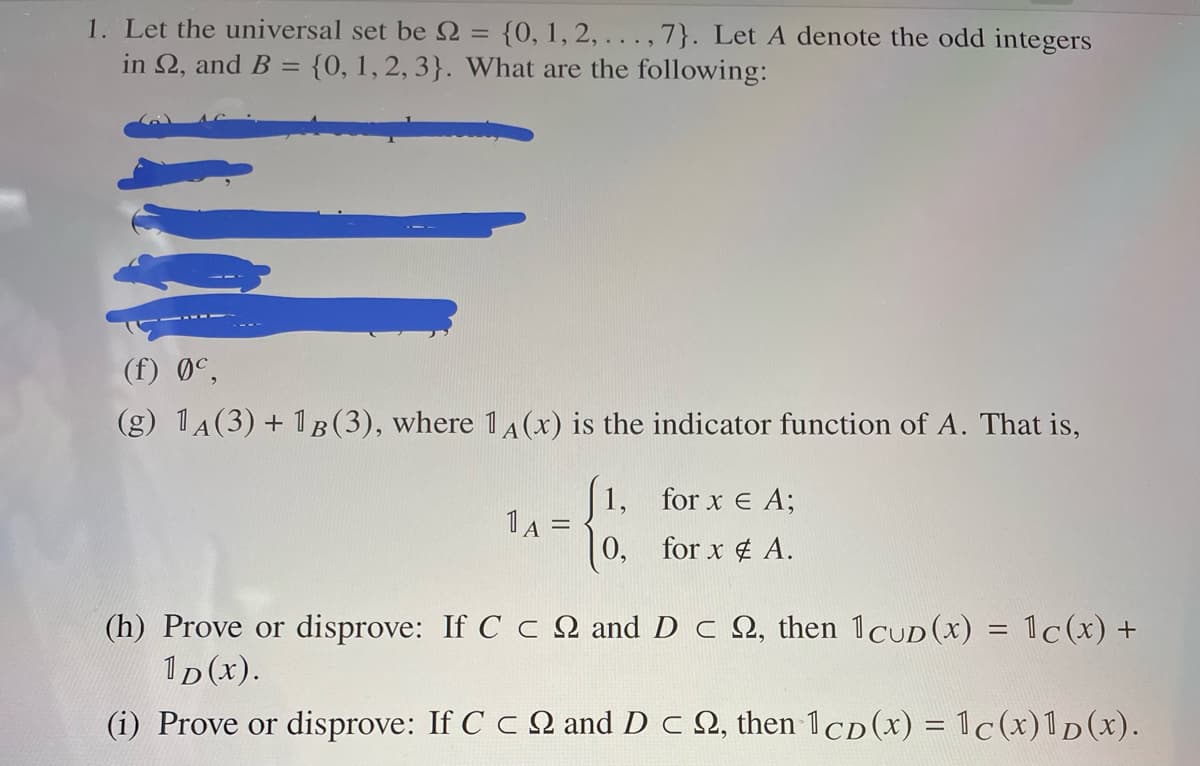1. Let the universal set be Q2 = {0, 1, 2, ..., 7}. Let A denote the odd integers in 2, and B = {0, 1, 2, 3). What are the following: (f) Øc, (g) 1A (3) + 1B (3), where 1A (x) is the indicator function of A. That is, 1A = 1, for x € A; 0, for x # A. and Dc , then 1 cup (x) = 1c(x) + (h) Prove or disprove: If C C 1D(x). (i) Prove or disprove: If C C 22 and DC 2, then 1 CD (x) = 1c(x) 1D (x).
1. Let the universal set be Q2 = {0, 1, 2, ..., 7}. Let A denote the odd integers in 2, and B = {0, 1, 2, 3). What are the following: (f) Øc, (g) 1A (3) + 1B (3), where 1A (x) is the indicator function of A. That is, 1A = 1, for x € A; 0, for x # A. and Dc , then 1 cup (x) = 1c(x) + (h) Prove or disprove: If C C 1D(x). (i) Prove or disprove: If C C 22 and DC 2, then 1 CD (x) = 1c(x) 1D (x).
Elements Of Modern Algebra
8th Edition
ISBN:9781285463230
Author:Gilbert, Linda, Jimmie
Publisher:Gilbert, Linda, Jimmie
Chapter1: Fundamentals
Section1.7: Relations
Problem 14E: In each of the following parts, a relation is defined on the set of all human beings. Determine...
Related questions
Question

Transcribed Image Text:1. Let the universal set be 2 = {0, 1, 2, ..., 7}. Let A denote the odd integers
in 2, and B = {0, 1, 2, 3}. What are the following:
(f) Øc,
(g) 1A (3) + 1 B (3), where 1A (x) is the indicator function of A. That is,
1A =
1,
0,
for x € A;
for x # A.
(h) Prove or disprove: If Cc and Dc , then 1CUD (x)
1D (x).
(i) Prove or disprove: If C C and D C , then 1 CD (x) = 1 c (x) 1D(x).
=
1c(x) +
Expert Solution
This question has been solved!
Explore an expertly crafted, step-by-step solution for a thorough understanding of key concepts.
Step by step
Solved in 4 steps

Recommended textbooks for you

Elements Of Modern Algebra
Algebra
ISBN:
9781285463230
Author:
Gilbert, Linda, Jimmie
Publisher:
Cengage Learning,

Elements Of Modern Algebra
Algebra
ISBN:
9781285463230
Author:
Gilbert, Linda, Jimmie
Publisher:
Cengage Learning,